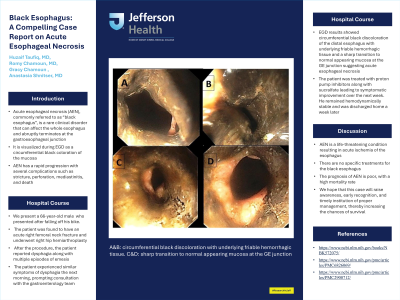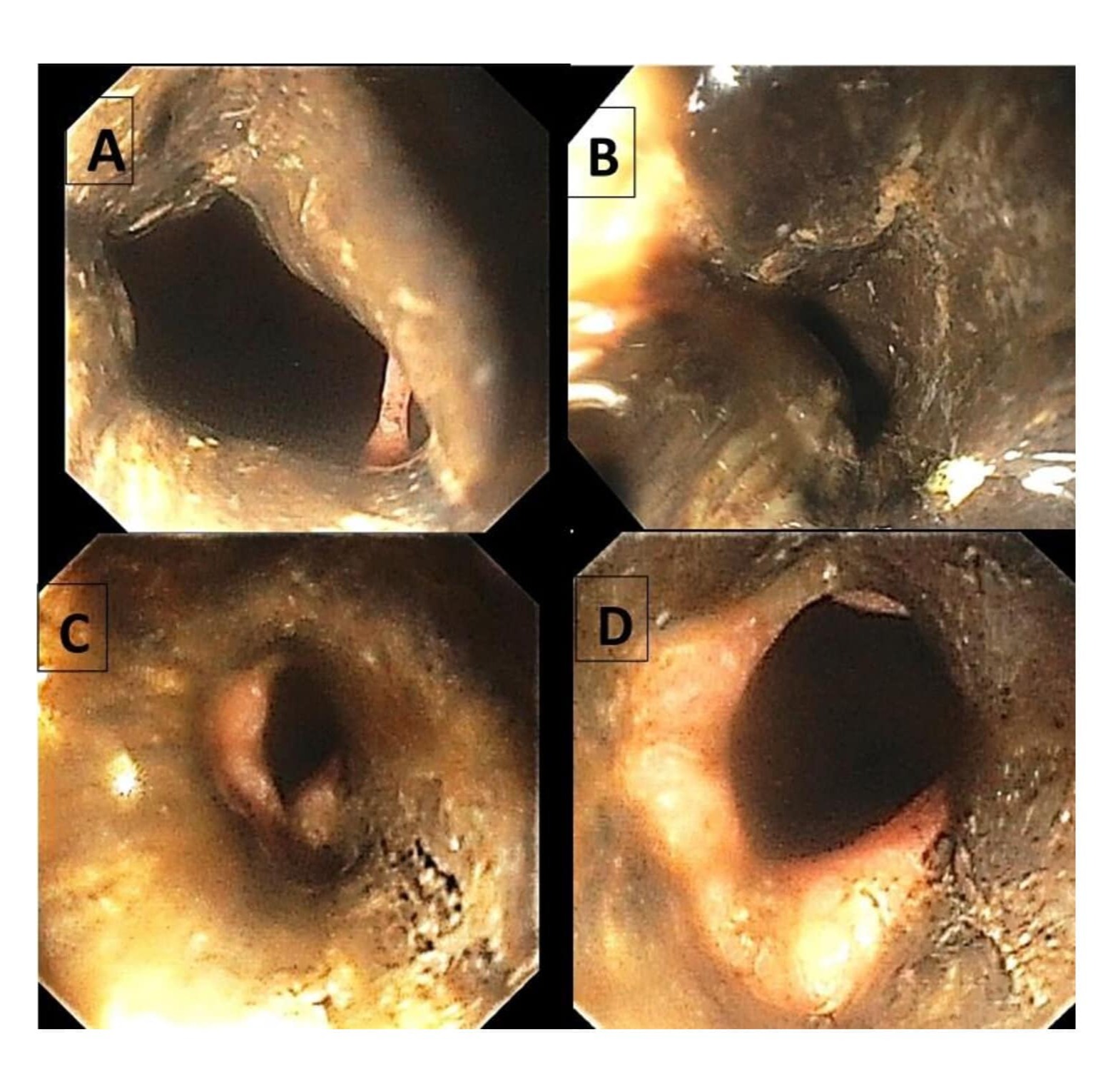Monday Poster Session
Category: Esophagus
P2246 - Black Esophagus: A Compelling Case Report on Acute Esophageal Necrosis
Monday, October 28, 2024
10:30 AM - 4:00 PM ET
Location: Exhibit Hall E

Has Audio
- HT
Huzaif Taufiq, MD
Jefferson Torresdale Hospital
Willow Grove, PA
Presenting Author(s)
Huzaif Taufiq, MD1, Romy Chamoun, MD2, Gracy Chamoun, BS3, Anastasia Shnitser, MD2
1Jefferson Torresdale Hospital, Willow Grove, PA; 2Lehigh Valley Health Network, Allentown, PA; 3University of Balamand, Arlington, VA
Introduction: Acute esophageal necrosis (AEN), commonly referred to as “black esophagus”, is a rare clinical disorder that can affect the whole esophagus and abruptly terminates at the gastroesophageal junction. It is visualized during esophagogastroduodenoscopy (EGD) as a circumferential black coloration of the mucosa and is believed to arise from a combination of an ischemic insult along with disruption of mucosal barrier systems, and reflux of gastric secretions. AEN has a rapid progression with several complications such as stricture, perforation, mediastinitis, and death
Case Description/Methods: We present a 66-year-old male with a past medical history significant for type 2 diabetes, and hypertension who presented after falling off his bike. The patient was found to have an acute right femoral neck fracture and underwent right hip hemiarthroplasty. After the procedure, the patient reported dysphagia, attributing it to a sensation of food becoming lodged in his chest along with multiple episodes of emesis. The patient experienced similar symptoms of dysphagia the next morning, prompting consultation with the gastroenterology team. He did not report having any similar episodes in the past. The patient was kept NPO with IV hydration and esophagogastroduodenoscopy was scheduled. EGD results showed circumferential black discoloration of the distal esophagus with underlying friable hemorrhagic tissue and a sharp transition to normal appearing mucosa at the GE junction suggesting acute esophageal necrosis. The patient was treated with proton pump inhibitors along with sucralfate leading to symptomatic improvement over the next week. He remained hemodynamically stable and was discharged home a week later
Discussion: AEN is a life-threatening condition resulting in acute ischemia of the esophagus. There are no specific treatments for the black esophagus, with the mainstay of therapy consisting of treating the underlying cause and supportive care. The prognosis of AEN is poor, with a high mortality rate of approximately 32% associated with other critical conditions, however, the mortality rate specific to AEN is 6%. We hope that this case will raise awareness, early recognition, and timely institution of proper management, thereby increasing the chances of survival

Disclosures:
Huzaif Taufiq, MD1, Romy Chamoun, MD2, Gracy Chamoun, BS3, Anastasia Shnitser, MD2. P2246 - Black Esophagus: A Compelling Case Report on Acute Esophageal Necrosis, ACG 2024 Annual Scientific Meeting Abstracts. Philadelphia, PA: American College of Gastroenterology.
1Jefferson Torresdale Hospital, Willow Grove, PA; 2Lehigh Valley Health Network, Allentown, PA; 3University of Balamand, Arlington, VA
Introduction: Acute esophageal necrosis (AEN), commonly referred to as “black esophagus”, is a rare clinical disorder that can affect the whole esophagus and abruptly terminates at the gastroesophageal junction. It is visualized during esophagogastroduodenoscopy (EGD) as a circumferential black coloration of the mucosa and is believed to arise from a combination of an ischemic insult along with disruption of mucosal barrier systems, and reflux of gastric secretions. AEN has a rapid progression with several complications such as stricture, perforation, mediastinitis, and death
Case Description/Methods: We present a 66-year-old male with a past medical history significant for type 2 diabetes, and hypertension who presented after falling off his bike. The patient was found to have an acute right femoral neck fracture and underwent right hip hemiarthroplasty. After the procedure, the patient reported dysphagia, attributing it to a sensation of food becoming lodged in his chest along with multiple episodes of emesis. The patient experienced similar symptoms of dysphagia the next morning, prompting consultation with the gastroenterology team. He did not report having any similar episodes in the past. The patient was kept NPO with IV hydration and esophagogastroduodenoscopy was scheduled. EGD results showed circumferential black discoloration of the distal esophagus with underlying friable hemorrhagic tissue and a sharp transition to normal appearing mucosa at the GE junction suggesting acute esophageal necrosis. The patient was treated with proton pump inhibitors along with sucralfate leading to symptomatic improvement over the next week. He remained hemodynamically stable and was discharged home a week later
Discussion: AEN is a life-threatening condition resulting in acute ischemia of the esophagus. There are no specific treatments for the black esophagus, with the mainstay of therapy consisting of treating the underlying cause and supportive care. The prognosis of AEN is poor, with a high mortality rate of approximately 32% associated with other critical conditions, however, the mortality rate specific to AEN is 6%. We hope that this case will raise awareness, early recognition, and timely institution of proper management, thereby increasing the chances of survival

Figure: A&B: circumferential black discoloration with underlying friable hemorrhagic tissue. C&D: sharp transition to normal appearing mucosa at the GE junction
Disclosures:
Huzaif Taufiq indicated no relevant financial relationships.
Romy Chamoun indicated no relevant financial relationships.
Gracy Chamoun indicated no relevant financial relationships.
Anastasia Shnitser indicated no relevant financial relationships.
Huzaif Taufiq, MD1, Romy Chamoun, MD2, Gracy Chamoun, BS3, Anastasia Shnitser, MD2. P2246 - Black Esophagus: A Compelling Case Report on Acute Esophageal Necrosis, ACG 2024 Annual Scientific Meeting Abstracts. Philadelphia, PA: American College of Gastroenterology.
